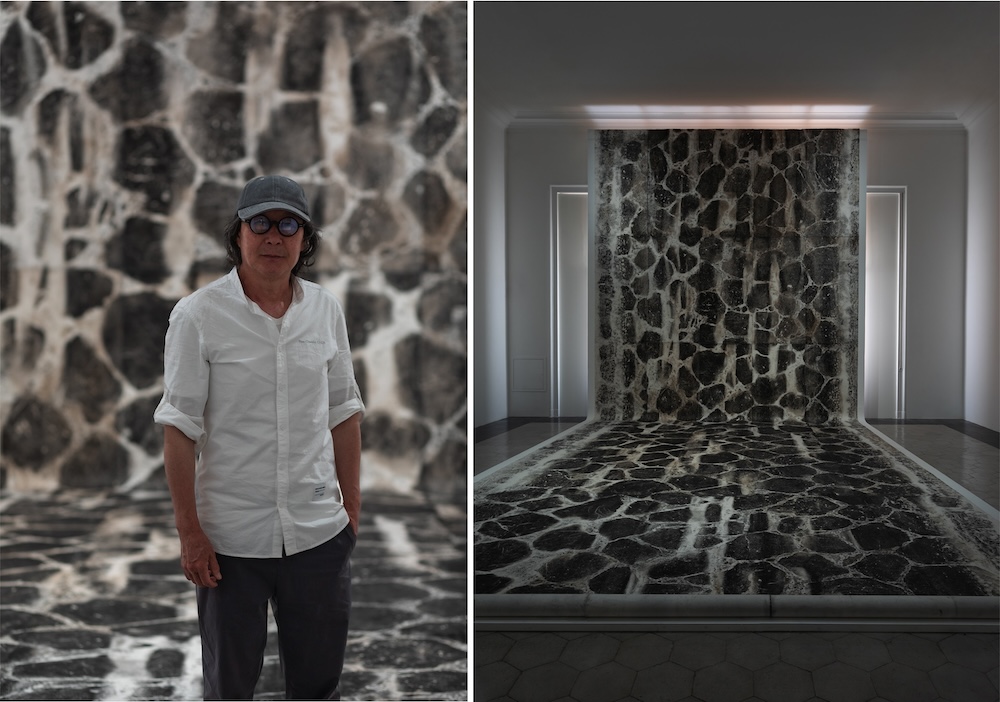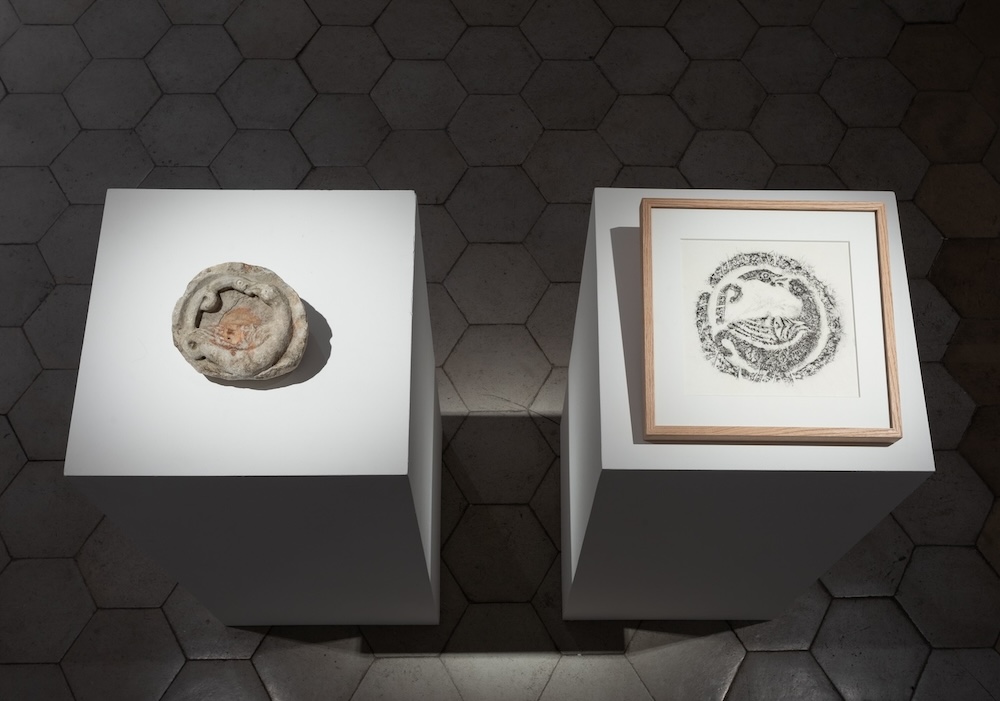The American Academy in Rome opened its gates on May 22 for the opening of our spring exhibition, A Moment in Time: Xu Bing in Rome, featuring new work by the Chinese-born visual artist who is AAR’s inaugural Tsao Family Foundation Resident in Art. Conceptual divisions were analyzed and dismantled by Xu Bing, who is known for his printmaking prowess and interest in language and text. “In my work, the separation between the classical and contemporary does not exist,” Xu states. “In its essence, the separation between the East and West also does not exist.”
The exhibition, on view through June 29 and curated by Andrew Heiskell Arts Director Ilaria Puri Purini, presents an installation of work that Xu completed during his residency entitled The Wall and the Road. The Wall harkens back to his 1988–91 work Ghost Pounding the Wall, a “rubbing” of a tower of the Great Wall of China. The Road, meanwhile, refers to one of the most famous roads of all: the Appian Way. Over the course of days, in the Roman sun and torrential rain, Xu painstakingly worked with Chinese and Italian students to make rubbings of a rural portion of the Appian Way between mile X and XI, about a dozen miles from the center of Rome.
Xu’s “rubbing” technique is an ancient method of duplication dating back to the Han dynasty, rich with cultural and conceptual associations. The process Xu uses in his practice is modernized. He and assistants cover the surface of an object with a thin layer of plastic, followed by Xuan paper, before “poaching” the paper with ink-soaked cotton pads. The fragile rubbing is then peeled away from the surface and must be reinforced before it can be exhibited. For Xu, this is not merely a return to a previous technique, but a kind of auto-quotation. “[A]n artist’s past works and present works form a closed ‘circle’ that belongs to the artist only,” Xu told museum director Davide Quadrio in an interview. “New works are the rediscovery of old works, and old works are the annotations of new works.”
The structure of AAR’s gallery space informs the piece itself, with the “wall” taking up one gallery and the “road” the other. (The scale of the works is impressive, taking full advantage of the gallery’s high ceilings.) The two galleries therefore bring together two sets of concepts; the wall, which can be seen as representing the East (and ancient Chinese civilization), and the road, representing the West (the Roman empire). While we know that contacts between the Roman empire and the Han dynasty were extremely limited, in this exhibition, Xu can unite them and compare them. (He also made two small rubbings of two antiquities from AAR’s Norton-Van Buren Archaeological Study Collection.) “Bringing together a wall and road that are representative of the ancient civilizations that produced them is a way to reflect on history and what remains of time, power, and empire,” said curator Ilaria Puri Purini.

The concepts of “wall” and “road” can be further complicated. According to interim Andrew W. Mellon Humanities Professor Allison Emmerson, the Via Appia Antica served as Rome’s “chief façade”: a means of communication and trade, but also a signifier and projection of power. In the gallery, the rubbing of the Appian Way is both wall and road at once, as the 22-meter-long rubbing unspools across the gallery floor like a pathway before forming a large a swoosh that terminates vertically on the far wall. (Or the work could equally be viewed as beginning on the wall; the absence of a clear direction is the point.)
The show is Xu’s vision, but his presence at the Academy can very much be linked to the vision of AAR’s Board Chair Calvin Tsao and the Tsao Family Foundation, which in 2022 endowed a new Residency for distinguished Chinese artists and a Rome Prize Fellowship for scholars working on the historical intersection of China and Italy in arts and ideas. “Both the Residency and the Fellowship were established with the aspiration to make connections between the thoughts and philosophies of the globe’s myriad and immensely varied cultures,” writes Tsao in a preface to the exhibition pamphlet. “Xu Bing’s exhibition fulfills these aspirations wonderfully, bringing into contact and to life the two ancient empires of China and Rome to illuminate the connectivity of human cultures through time and domain.”
Putting on the exhibition has indeed allowed AAR to forge new connections with institutions such as Hang Seng University of Hong Kong and Hong Kong Metropolitan University, and to expand programming to include East Asian studies. Among the approximately 450 visitors at the show’s opening, and the fifty at an exhibition walk through and talk on May 29, were Chinese fine art students, East Asian studies professors, and a public interested in seeing Rome through a different lens. At the May 29 panel, John Delury, AAR’s Tsao Family Rome Prize and a professor of Chinese Studies at Yonsei University in Seoul, conversed with Ornella De Nigris, a researcher of Oriental Studies at the University of Siena. Delury explained that in Chinese, the term for China’s wall is often understood as walls or long wall, highlighting the history of its building which started as several different walls. Delury and De Nigris also reflected on the timeliness of this exhibition amid an increasingly fraught geopolitical situation in which “East” and “West” become loaded terms.

Ilaria Puri Purini was glad the show could so successfully blend with Eastern Asian scholarship, particularly at the May 29 talk. “This exhibition enabled us to get in touch with experts from Chinese culture and discover the connections existing between China, US and Italy,” she said.
Romans can look forward to one more public event relating to the exhibition: a finissage on June 27 that will present an evening of performances with multidisciplinary artists Peng Shuai Paolo and Vanshika Agrawal. Mark your calendars.
The exhibition is made possible by the Tsao Family Foundation Residency in Art.
Con il patrocinio del Comune di Roma.